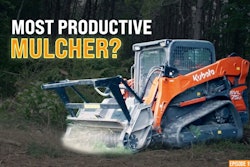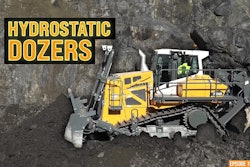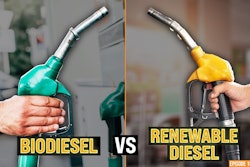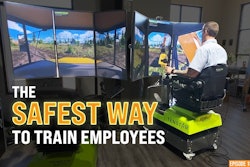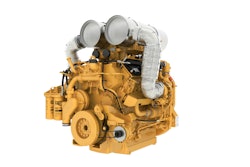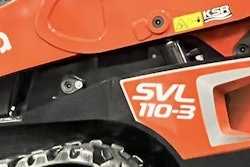Skid steers and compact track loaders are made for running all kinds of attachments, and those attachments come in a variety of sizes and performance levels.
So how do you know what’s the best tool for your compact loader?
On this episode of The Dirt, Chrisopher Storr, product training manager for Blue Diamond Attachments, walks us through the process for choosing the correct tool and why sometimes the “biggest and baddest” attachment is a terrible choice.
Storr explains that the process of choosing the right attachment starts with answering some simple questions. He also discusses the situations when its best to use standard flow versus high flow. He even delves into the different types of brush cutters and how to make sure you get the right one for your machine.
So to learn more about choosing the right attachment for your skid steer or compact track loader, check out the latest episode of The Dirt.
Equipment World serves up weekly videos on the latest in construction equipment, work trucks and pickup trucks – everything contractors need to get their work done. Subscribe and visit us at equipmentworld.com!
In This Episode:
- 00:00 – How to Size Skid Steer Attachments
- 00:39 – Knowing What Attachment is Right for You
- 01:29 – Attachment Specs to Keep in Mind
- 03:10 – High Flow vs. Standard Flow
- 04:19 – What Attachments Need High Flow?
- 07:38 – 0% Interest for 48 Months
- 08:52 – Choosing the Right Brush Cutter
- 12:41 – Brush Cutter Safety Concerns
- 14:54 – Final Thoughts
00:00:00:10 - 00:00:24:05
Bryan Furnace
Today we're here to talk about skid steer attachments. But we're not just talking about skid steer attachments. In general. We've had those conversations. We're always talking about skid steer attachment. One of the conversations we haven't really had is how do you appropriately sized skid steer attachments?
00:00:24:07 - 00:00:38:17
Bryan Furnace
Do you just go for the biggest, meanest, greatest, baddest attachment you can find? Or is there a little more to it? Here to talk to us today is Chris from Blue Diamond.
00:00:38:19 - 00:00:57:14
Bryan Furnace
So my first question for you is, as a contractor, if I'm going to go in and I'm going to go buy an attachment for my skid steer, what are some of the questions that I need to be asking myself to ensure that I'm not just going to go get the biggest, baddest attachment there is. I'm actually going to get something that is going to be productive on my machine.
00:00:57:16 - 00:01:14:05
Christopher Storr
Yeah. So the first thing we just kind of drilled into how we operate is we ask a ton of questions, and really it's about setting customer expectations. So we're trying to figure out what are you actually doing. May depend on the part of the country, the type of dirt, the type of rock that you're dealing with, the conditions you're working in.
00:01:14:05 - 00:01:28:17
Christopher Storr
Surely that's where it starts with. It's asking relevant questions to try and qualify what your expectations are, what are you trying to achieve? And then from there you can slowly advance it to get more technical. But we try to keep it simple and kind of educate the customer in the process of doing so.
00:01:28:23 - 00:01:48:14
Bryan Furnace
So when you say you start to get a little more technical, there's so many contractors out there that they just want to go after. What is the biggest, baddest attachment of whatever I'm looking for, whether it's an auger or it's a stump grinder or it's a brush cutter, I'm just going to get the biggest and baddest. But but I do get there are some technical questions I need to ask myself too.
00:01:48:14 - 00:01:51:16
Bryan Furnace
What are some of those sort of technical questions?
00:01:51:18 - 00:02:06:15
Christopher Storr
Yeah, 100%. So there may be a little bit of ego attached to it. You know, when you say, hey, this is what I need, you know, I need a mulching head. And then what you find out is say, so that's where you go with the customer expectations. Say, okay, well, this is what the finished product is going to look like.
00:02:06:15 - 00:02:27:04
Christopher Storr
This is what I'm envisioning. This is what I've got to get done. So then on the technical aspect, you don't have to be completely mechanically inclined, but you can definitely identify things like the the GPS. How many gallons per minute does the desert, how it's machined have capacity for? Does it require a 14-pin electrical connection. You know, what's the horsepower?
00:02:27:04 - 00:02:50:19
Christopher Storr
What's the breakout force? What's the rated operating capacity, all these basic numbers that are associated with that model machine. And then you take it from there. Then you may want to get into a heavier duty class attachment for something elementary like we consider basic like a grapple. You definitely don't want that thing to have too much strength and breakout force that it's literally curling the grapples.
00:02:50:19 - 00:03:08:21
Christopher Storr
You also don't want something that's going to be putting out a number of gallons per minute. That is on the low end of the range of the motor, or just below what the motor respect for, so that it comes back to where we started, customer expectations. And you want to make sure that thing is going to be optimally performing.
00:03:08:23 - 00:03:25:05
Bryan Furnace
Yeah, I like how you've kind of transitioned to talking to my gallons for a minute, because one of the things that always comes to mind is when do I need high flow versus standard flow? And, and I feel like most people just have the mentality of, well, we're just always going to go high flow because high flow has to be better.
00:03:25:06 - 00:03:27:08
Bryan Furnace
Can you kind of break that down for me?
00:03:27:10 - 00:03:56:19
Christopher Storr
If you've got high flow, use it. But if you've got standard flow, that doesn't really out of the game. I mean, we have a standard flow brush cutter. That's one of our bestselling items in the entire lineup of products that we offer, and it's definitely not to be underestimated. The thing to understand about that, without getting too much into the nuts and bolts about it, is that when you're putting a standard flow hydraulic motor on a standard flow machine, understand that that motor is tuned to work at that peak performance at that GPM.
00:03:56:21 - 00:04:16:03
Christopher Storr
The other thing there too, is if you've got a fleet of equipment, you've got a bunch of operators on the payroll and guys are jumping in switching machines. If they were to turn on a high flow machine, turn on the high flow circuit, it's not going to take very long before they blow seals or have some, some, issues with the standard flow attachment.
00:04:16:05 - 00:04:18:15
Christopher Storr
So it's a little bit of protection there for you as well.
00:04:18:20 - 00:04:39:08
Bryan Furnace
Can you also kind of qualify. There's certain attachments that do well as high flow attachments. But then there are a lot of attachments that you don't really need high flow for at all. Standard flow is going to be just fine. Can you kind of talk about some of that?
00:05:20:10 - 00:05:38:11
Christopher Storr
Yeah. So any attachments sort of like a grapple that just push pull your open closing that simple. Is that a broom. You're just spinning a trencher. Other items like that that are just that's all they're doing is just going in one direction or just doing a short stroke on a cylinder. High flow is not going to be required.
00:05:38:11 - 00:06:05:21
Christopher Storr
Typically there would be some exceptions to that, but generally speaking it's going to be straightforward. A standard flow range is going to have the capacity to make that happen. When you're getting into the higher speed, higher rotation, it's like a mulcher drum mulcher disc motor, brush cutters. And when we say brush cutters were typically referring to like the rotary cutter style that applies to skid steer mainly when you get into excavators is a little bit different on the terminology there as far as auxiliary circuits are concerned.
00:06:05:21 - 00:06:23:15
Christopher Storr
But yeah, standard flow will suffice for a wide range of attachments. High flow selectively as needed. Another one called Planers where you're doing that milling, you know, that's a very heavy, aggressive, long duration operation. And high flow would be ideal for those applications to.
00:06:23:17 - 00:06:39:18
Bryan Furnace
What I used to tell my customers back when I sold equipment is if you really want to break it down into simple terms, you don't need a high flow machine unless you're really running something like a mulch head or a planer. Pretty much everything else, you're going to be able to get away with standard flow and it'll be just fine.
00:06:39:18 - 00:06:55:10
Bryan Furnace
Now, if we're talking about doing production in postal ordering or you're in some really tough conditions, sure, stepping up in a high flow can help, but there's so many of those attachments that really high flow is almost overkill on them. Standard flow is going to get you through just fine.
00:06:55:12 - 00:07:17:06
Christopher Storr
Yeah. And it's interesting to watch. You know, we've got 25, 30 years under our belt now as a manufacturer. And it's interesting to watch the transition in the market. As the machines are getting bigger, the capacities are getting larger. Even the even the mini track loader stand down right on units, walk behind units. Some of them originally were walk behind you even watch them grow in strength to pretty much the capacity of a small frame.
00:07:17:06 - 00:07:42:08
Christopher Storr
Skids to your class, and it's interesting to see what those machines can do. And then of course, as an attachment manufacturer, we're looking at what those machines are really capable of, what they're designed to do. And those applications are expanding. Those applications are growing. It's exciting. But bearing in mind that you want to make sure that it's paired well, you know, sometimes the other thing we find is 0% for 48 months.
00:07:42:10 - 00:08:02:22
Christopher Storr
And unfortunately, sometimes there may be some OEM pressure to kind of put them into a one size fits all attachment. And it may not be designed specifically for that application. The 0% is attractive, but you got to ask yourself as an end user, hey, listen, is this really going to meet my expectations? Does that make sense?
00:08:03:00 - 00:08:25:20
Bryan Furnace
Yeah. And to go kind of a step further in explaining that a lot of times as dealers, we would stock the bottom of the line attachment. We would get the entry level brush cutter, and we would stock 5 or 10 of those because, you know, as a dealer, let's be honest, we have a lot of homeowners that come in and they will they don't need the beefy, baddest model of brush cutter or stone grinder, whatever.
00:08:25:22 - 00:08:46:02
Bryan Furnace
And so if you as a contractor go in and like you said, hey, you know, we can roll this attachment in with your loan. And by the way, we've got one sitting here in the lot. If you don't do your due diligence in your homework, you may go home with a tissue paper brush cutter that you think you're going to go out and start doing production land clearing with, and it's just not going to work.
00:08:46:02 - 00:09:03:23
Bryan Furnace
And now you've you've wasted that money. Yeah. You got zero for 48 on it, but you've wasted that money. We're starting to get into kind of the brush cutter discussion and brush cutters have, especially here in Michigan, because baiting for deer is no longer a thing. It is. It is huge. It's a huge business now to go out and make food plots.
00:09:03:23 - 00:09:29:04
Bryan Furnace
And so brush cutters have become a massively popular attachment. But if you go into pretty much anyone's archive or inventory of brush cutters, there are 50 different options out there. Can you kind of break down some of the different options and maybe why one brush cutter style would be better than another one? And when you need to go from an extreme duty to a severe duty and just kind of break down some of the differences in those for us.
00:09:29:06 - 00:09:47:20
Christopher Storr
Yeah. Good. So firstly, with regards to extreme duty and severe duty, you always want to understand the terminology, how that manufacturer is labeling it. And really the simplest way to do that would be to look at what's the rated cutting capacity. So there's always going to be a rated cutting capacity. It's going to say hey this is 2- to 3-inch material, six-inch material, seven-inch material.
00:09:47:20 - 00:09:53:01
Christopher Storr
We go up to ten-inch material. This would be for skids to your cutters, of course, is what we're talking about at the moment.
00:09:53:03 - 00:09:59:07
Bryan Furnace
And we as contractors know we can easily double, maybe triple that number before we run into problems.
00:09:59:09 - 00:10:06:01
Christopher Storr
That that would be. Unfortunately, common sense doesn't necessarily always prevail. But you're absolutely correct.
00:10:06:03 - 00:10:07:01
Bryan Furnace
Absolutely.
00:10:07:05 - 00:10:33:23
Christopher Storr
We we we totally understand that things are going to be pushed to the limits, but that's just a good sort of baseline to understand. If you go by the cutting capacity, what's it rated for that's as advertised. That's you know what the what we can stand behind and say, hey, this is what it will do. Bearing in mind it's probably been pushed to the limits and tested for more, or there may be some safety constraints there that you want to be bearing in mind as an operator, what we would recommend the next thing as far as the options.
00:10:33:23 - 00:10:50:03
Christopher Storr
So once you've figured out the class and the sort of the overall construction of the deck reinforcements and all that other kind of thing, because it's it's more than just the hydraulic motor and the gallons per minute. Right. We've already talked about stem flow and high flow. Then you got to look at like, how is the deck reinforced?
00:10:50:08 - 00:11:09:14
Christopher Storr
How is the front? Of course we've got the open fronts. They're going to look bigger and better. As you've said much more aggressive. It exposes the tips of the blades or the tips of the the teeth there that allows those blades to engage with that larger material. And that's obviously why the cutting gets gets larger. And then you've got to close.
00:11:09:14 - 00:11:31:09
Christopher Storr
Right. So close front may be better suited for a maybe a so-called amateur or maybe even in a rental application where you don't want that liability associated with it. If that machine is being rented out, really, it's establishing the cutting capacity, understanding that you're operating in that correct hydraulic flow range. Do you need an open front or a closed front?
00:11:31:11 - 00:11:45:18
Christopher Storr
And then of course, as we mentioned before, like rated operating capacity, you want to look at the overall weight of the unit, because if that you had a 72-inch cutter or thereabouts, you know, it's six foot out in front of your machine. So you need to be mindful of that kind of thing as well. You don't want to be on your nose.
00:11:45:18 - 00:11:52:05
Christopher Storr
You need to be able to have the strength and the counterweight in the back to be able to handle it appropriately.
00:11:52:09 - 00:12:10:20
Bryan Furnace
I will, if I may add to your open face versus closed face. One of the things I always talk to my customers about was, if you're going to be around buildings, people on the side of a highway, it's generally going to be better to have that closed face because the head isn't going to start throwing material when you get into it.
00:12:10:20 - 00:12:30:20
Bryan Furnace
As you said, you actually almost get a mulching effect or a grind effect because it's trapping that material within that housing, and it's allowing that material to get eaten up a little more, versus if you're in an application where you're getting into trees, you're starting to do a little more. Not full of lane clearing brush cutters aren't really built for that, but you are starting to take down some saplings and some decent trees.
00:12:30:22 - 00:12:41:07
Bryan Furnace
You're definitely going to want that open front with the push bar, because those exposed blades are going to allow you to get up to that tree and kind of snap the top off of it and then start mulching your way down.
00:12:41:09 - 00:13:08:04
Christopher Storr
Yeah, correct. And you've got to be conscious of that, that you're dealing with a machine that could be potentially lethal if it's mishandled and not used appropriately. Projectiles can fly. It doesn't matter if it's a standard flow. It doesn't matter if it's high flow. Projectiles can fly. Matter of fact, that's why there's there's two recommendations. Always, we would make for an operator is, number one, never get out of your machine until the attachment has stopped moving.
00:13:08:04 - 00:13:27:09
Christopher Storr
Yes. Even as, like, a mulching head is winding down or something like that, something may suddenly become dislodged. And that could be a problem for you. And never at any point from the operator's perspective, never at any point do you want to be able to see the blades or teeth moving. You're in a bad position because you're in the line of fire at that point.
00:13:27:11 - 00:13:36:21
Christopher Storr
So those are just two simple tips. You'll never be able to see the blades or anything turning and do not exit the machine until the thing is completely come to a stop.
00:13:37:03 - 00:13:53:22
Bryan Furnace
And you know what? I'm going to cover one more factor that. Let's be honest, Chris, you and I should not have to say don't ever run a mulcher or a brush cutter with an open cab unit or a cab with a standard door. It has to have the demo door. You're going to kill yourself. Otherwise.
00:13:54:00 - 00:14:11:00
Christopher Storr
Yes. That's that's a very serious point. And, you know, it comes back to where we started with this about, you know, right sizing your attachment. You know, how is your machine specked. There's a lot of machines that come from the factory, come from the manufacturer with a demo door, a forestry package, whatever. They may sell it to us.
00:14:11:00 - 00:14:21:18
Christopher Storr
As a manufacturer, we also provide that, you know, we use that as a as an upselling tool. Once we've qualified the opportunity and figured out, hey, this is the right tool for your application, this is going to get the job done. It's going to meet your expectations.
00:14:21:21 - 00:14:43:23
Bryan Furnace
I was going to say, as a contractor that uses these kind of attachments regularly within the first 20 minutes of getting in that cab and running that attachment, you will know why the salesperson insisted you buy the demo door, and it will scare the snot out of you when it happens, because that bang against that glass six inches in front of your face is so loud, you're going to no thank you.
00:14:43:23 - 00:14:45:07
Bryan Furnace
You're going to thank your salesperson.
00:14:45:09 - 00:14:46:19
Christopher Storr
I've been there, done that.
00:14:46:21 - 00:14:51:05
Bryan Furnace
Well, Chris, thank you so much for the time. Thank you for all the information on sizing attachments I appreciate it.
00:14:51:10 - 00:14:54:06
Christopher Storr
No problem. Brian, we're here to help. That's what we love to do.
00:14:54:12 - 00:15:11:15
Bryan Furnace
Well, thank you again for Chris coming on the show to help us understand the process and the science behind actually sizing an attachment for your machine versus just going for the biggest meatiest attachment you can find. As always, I hope this helps you and your business. We'll catch you on the next episode of The Dirt.
